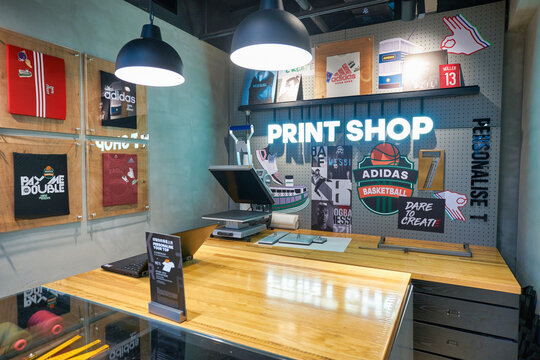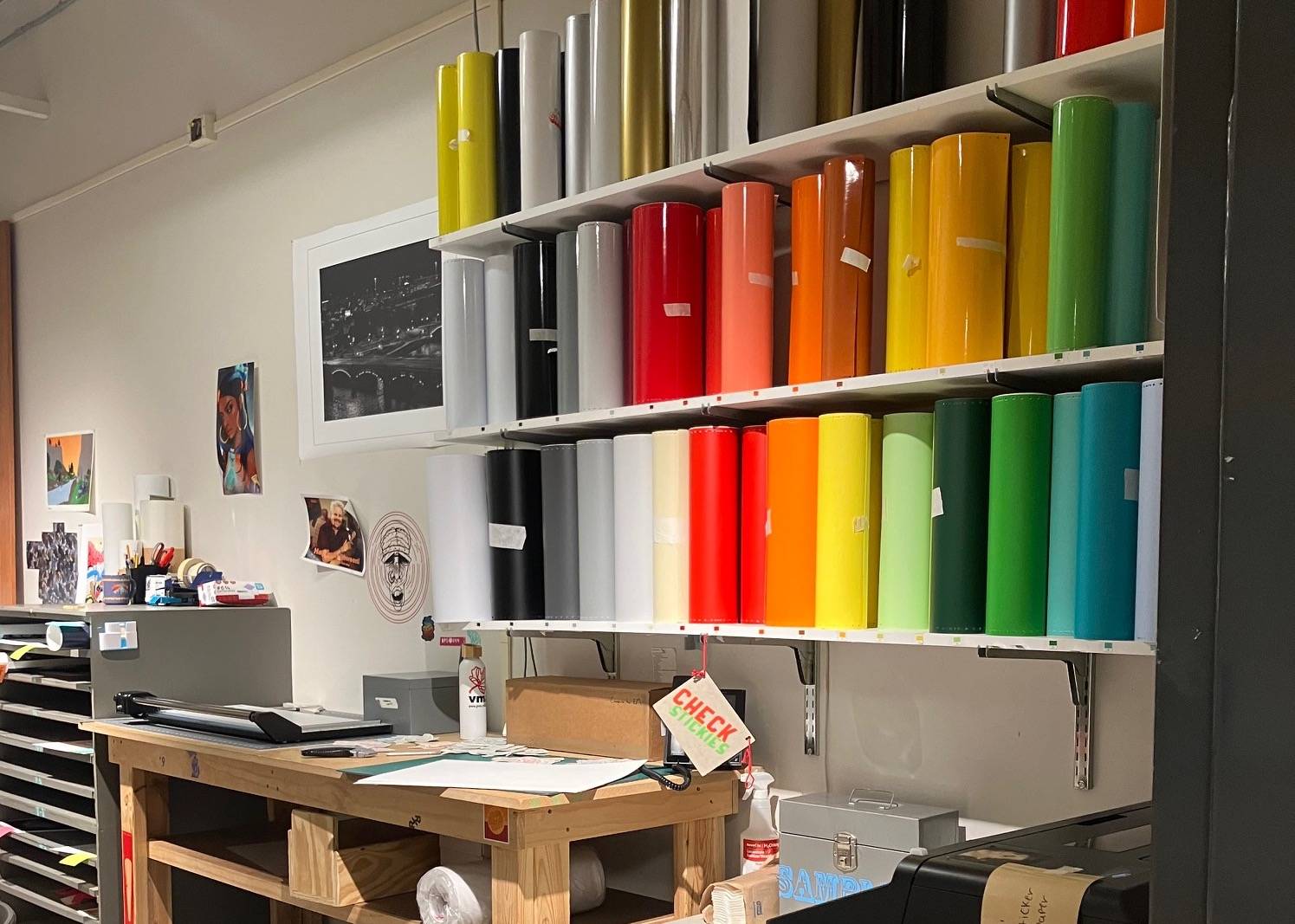7 Surprising Benefits of Using a Print Shop Near Me for Custom Artwork
7 Surprising Benefits of Using a Print Shop Near Me for Custom Artwork
Blog Article
The Ultimate Overview to Utilizing Printing Providers for Custom-made Art Prints
Guiding through the globe of customized art prints calls for a clear understanding of different printing services. Musicians must take into consideration elements such as printing strategies and materials to attain the preferred end result. Each decision, from art work preparation to color calibration, plays an important duty in the end product. As they explore these aspects, musicians can reveal the capacity for their job to link with target markets in a meaningful method. What actions can they take to assure their prints stand apart?
Recognizing Various Types of Printing Providers
Although many individuals might overlook the ins and outs of printing services, comprehending the different kinds readily available is necessary for anyone seeking to develop personalized art prints. The most common kinds consist of electronic printing, counter printing, and screen printing. Digital printing is preferred for its fast turnaround and ability to produce top notch pictures directly from electronic documents, making it ideal for tiny runs. In contrast, countered printing deals remarkable picture high quality and is economical for bigger amounts, using plates to transfer ink onto paper. Screen printing, typically used for textiles and promotional things, entails pressing ink through a mesh screen, permitting vivid shades and structures. Each technique has its unique benefits and constraints, making it crucial for artists and designers to analyze their certain requirements, such as quantity, desired top quality, and spending plan, before selecting a printing solution that straightens with their creative vision.
Selecting the Right Materials for Your Prints
Choosing the suitable products is necessary for attaining top notch personalized art prints. Comprehending the different kinds of paper and the value of ink high quality can substantially affect the outcome. Musicians must think about these aspects to ensure their vision is accurately stood for in the printed item.
Paper Types Explained
Picking the appropriate paper kind is necessary for achieving the wanted aesthetic and toughness in customized art prints. Numerous options exist, each offering unique characteristics. As an example, glossy paper improves shade vibrancy and information, making it ideal for digital photography prints. Conversely, matte paper supplies a softer coating, which is more suitable for art work that calls for subtlety and structure. Great art paper, typically made from cotton or alpha cellulose, offers historical quality and is appropriate for reproducing detailed details in paints (Print Shop Near Me). In addition, specialty documents, such as watercolor or canvas, can include distinct aesthetic impacts. Eventually, selecting the suitable paper kind will significantly affect the last presentation, guaranteeing that the art work is both aesthetically appealing and lasting
Ink High Quality Issues
Ink quality plays a necessary role in the general success of custom art prints. High-quality inks ensure vivid shades, sharp information, and longevity, which are important for showcasing imaginative work. When picking printing services, artists must consider pigment-based inks over dye-based alternatives, as they offer much better fade resistance and color security. Furthermore, the choice of ink should complement the picked paper kind, improving the print's visual impact. Environmental variables, such as moisture and temperature, can also affect ink efficiency; consequently, artists ought to ask about ink formulations that resist these components. Eventually, buying superior ink top quality can raise the end product, guaranteeing that the art print remains real to the artist's vision for many years to come.
Discovering Printing Methods: Digital vs. Conventional
While both electronic and standard printing methods have their distinct benefits, the decision on which approach to use frequently depends upon the certain needs of the art work. Digital printing masters flexibility and rate, enabling quick turn-around times and the ability to publish as needed. This approach is especially advantageous for musicians who require tiny runs or special pieces, as it removes the need for substantial setup processes.Conversely, standard printing techniques, such as lithography and screen printing, often create richer colors and appearances, appealing to artists looking for an extra authentic and responsive finish. These methods can improve the deepness and quality of the artwork, making them appropriate for bigger editions. Additionally, typical methods may use a distinctive visual that digital printing in some cases battles to reproduce. Ultimately, the option between these methods need to consider elements like preferred high quality, amount, and imaginative intent, leading musicians to the most suitable option for their projects.

Preparing Your Artwork for Printing
Successfully preparing artwork for printing needs cautious interest to information, no matter the selected printing strategy. Musicians have to assure that their documents are developed at the ideal resolution, generally 300 DPI, to preserve sharpness and clearness. The appropriate color mode, typically CMYK for print, is important to accomplish the preferred shade accuracy. Musicians must also consider the measurements of the art work, seeing to it to include bleed locations if essential, to stop any kind of undesirable white edges after trimming.Additionally, file formats play an important duty; TIFF and PDF are usually favored for high-grade prints. Prior to entry, it is necessary to assess the artwork for any type of blemishes or unwanted components. By diligently examining these elements, artists can boost the probability of their prints aligning with their imaginative vision, eventually resulting in an effective printing result.
The Importance of Color Calibration and Proofing
Shade calibration and proofing are crucial action in the printing procedure, as they ensure that the final output accurately reflects the musician's vision. Proper shade calibration assurances that the shades displayed on the screen suit those that will certainly be published. This process includes changing the display settings, printer accounts, and inks to attain a consistent color representation.Additionally, proofing enables artists to sneak peek their work before the final print run. This stage allows them to detect and remedy any kind of discrepancies in detail, color, or saturation, thereby minimizing pricey errors. By utilizing digital or hard-copy proofs, musicians can make educated decisions about changes needed for suitable results.Incorporating shade calibration and proofing into the printing process not only improves the high quality of the last product yet additionally fosters a dependable partnership in between the printing and the musician service, guaranteeing satisfaction and fidelity to the original artwork.
Choosing the Perfect Dimension and Style for Your Prints

Marketing and Marketing Your Custom-made Art Prints
Advertising and selling custom-made art prints requires a strong brand name identification to stick out in an open market. Effective online promo methods and the tactical usage of social networks systems can significantly improve visibility and interaction. By integrating these elements, artists can develop a compelling existence that draws in possible customers.
Structure Your Brand Identification
Developing a solid brand name identity is crucial for artists aiming to efficiently market and offer their customized art prints. This identification encompasses the musician's one-of-a-kind design, values, and story, which resonate with prospective purchasers. Musicians ought to produce a natural visual visibility throughout all platforms, including logo designs, color pattern, and typography that mirror their imaginative vision. Furthermore, a clear goal declaration aids communicate the artist's purpose and enthusiasm. Involving narration concerning the inspiration behind each piece can foster psychological connections with the audience. Uniformity in messaging, whether on social networks or product packaging, boosts acknowledgment and depend on. By very carefully curating their brand identification, musicians can differentiate themselves in a competitive market, attracting devoted consumers who value their artistry.
Reliable Online Promo Approaches
What approaches can musicians utilize to successfully advertise their custom-made art publishes online? First, developing a professional web site showcasing the artwork is essential. This site ought to consist of detailed descriptions and top quality images to engage potential customers. Additionally, musicians can use email advertising by constructing a client checklist to share updates, promos, and new releases. Working together with blog writers and influencers in the art neighborhood can broaden reach and reputation. Supplying limited-time price cuts or unique pieces can also create urgency, motivating acquisitions. Enhancing content for search engines with appropriate key words will improve exposure. Maintaining a blog site about the artistic process can draw in art enthusiasts, cultivating a much deeper link with the audience and improving the overall marketing approach.
Making Use Of Social Media Platforms
Social media systems function as powerful tools for artists looking to market and sell their customized art prints. By leveraging systems like Instagram, Facebook, and Pinterest, artists can display their work to a substantial target market. Engaging visuals and calculated hashtags can boost exposure, drawing prospective buyers to their accounts. Regularly posting material, such as brand-new layouts or behind-the-scenes processes, helps preserve audience interest and fosters a sense of area. Furthermore, artists can utilize targeted marketing to get to details demographics, improving the chances of sales. Cooperations with influencers or other artists can even more enhance exposure. Eventually, a well-curated social media sites visibility not just promotes customized art prints yet also develops a dedicated customer base gradually.
Frequently Asked Concerns

How Do I Discover Trusted Printing Service Providers?
To locate trusted printing service companies, one must research on-line testimonials, seek suggestions from peers, compare profiles, demand examples, and evaluate customer care responsiveness. This extensive approach assurances notified choices and satisfying outcomes.
What Is the Common Turn-around Time for Custom Prints?
The normal turnaround time for custom prints varies by copyright, however generally varies from a few days to 2 weeks. Aspects influencing this include order size, complexity, and the specific printing strategies used.
Can I Get a Reimbursement if I'm Not Pleased With My Prints?
The question of obtaining a refund for poor prints typically depends on the certain printing solution's policies. Several business offer satisfaction assurances, while others might have rigorous return conditions, stressing the importance of assessing terms beforehand.
Exist Any Type Of Hidden Prices Related To Printing Providers?
Several printing solutions might include concealed prices such as arrangement fees, shipping costs, or additional charges for details products. It's crucial for clients to make inquiries about all prospective expenditures before settling their order.
Exactly How Can I Ensure My Prints Are Ecologically Pleasant?
To assure prints are environmentally pleasant, one should choose environment-friendly inks, recycled paper, and sustainable printing practices. Investigating printing services that focus on sustainability and obtaining accreditations can even more assure minimal environmental impact in the printing process. Guiding have a peek at this website through the world of custom art prints requires a clear understanding of numerous printing solutions. Several individuals might forget the complexities of printing visite site solutions, understanding the different types offered is vital for anybody looking to produce personalized art prints. The most common kinds include electronic printing, offset printing, and display printing. Successfully preparing artwork for printing calls for careful interest to information, regardless of the chosen printing method. Prints intended at galleries might require conventional dimensions to promote framing, whereas special layouts may appeal to collectors looking for something distinctive.Lastly, the printing service's capacities must be evaluated.
Report this page